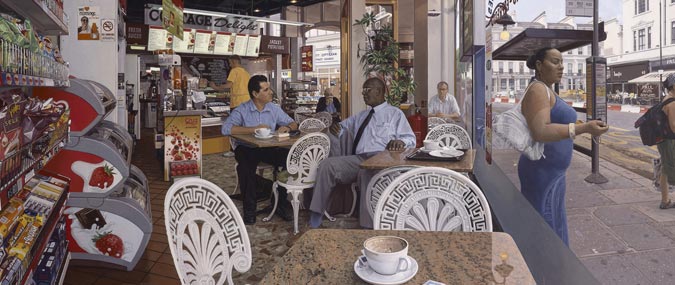This autumn, to coincide with the Sainsbury Wing exhibition Venice: Canaletto and his Rivals, the National Galley is inviting two contemporary artists to display work looking at the urban landscape. The first of these artists, Clive Head, will display three works exploring new ways to represent London.
About Clive Head
In Canaletto, Clive Head finds an artist who, like himself, reinvents the urban landscape, creating paintings which resemble the real world without simply repeating it.
Head gathers visual information from site drawings, photography and studio studies. He combines these images to create artwork with surprising results. Head does not repeat a single viewpoint like a camera. Instead he shows multiple views in a single painting. The resulting works capture the experience of looking and moving around a scene.
In conversation
Transcript
Jools Holland:
There is one of your paintings in our studio and all the musicians who come look at it. And the ones who have come back again, you’ll often find them looking at it and looking at it again, because you can just keep returning to them and finding something else in them.
Which I think is also true of great pieces of music; you can come back to them years later and the good ones they really were good, they were even better than I thought; and there are other ones when you think, well, actually I’ve moved away from that now.
But I think it’s that thing of when you first see something, or when you first hear a piece of music, you can be drawn to it.
Sometimes you have to look further and further but it’s that initial response of,
‘Oh, that’s great, that sounds great, that looks great, I’ve got to look at it more and more.’
And I think this painting has that, it’s very exciting. And I think that anyone who sees this, if you see it across a room it makes you – they draw you in, so you’re drawn towards them.
It’s almost like the transitory atmosphere of landscape is in these – of a cityscape – which changes as the light changes, as the weather changes. You’ve managed to capture a moment, which couldn’t be captured in a photograph – it couldn’t be captured in a film somehow. You’ve captured it, you know.
To write a song or to do music you have to go over the same thing again a few times, because you’re mystified or you love it, or you’re trying to figure it out, and I think that’s the same with painters.
I think you can see that when they first start; they’re trying to figure it out. And to do the simplest thing but to get it just right is the other thing that I think musicians and painters have.
Some things infuriate them; somebody will hear something and say,
‘Well, that sounds great what you did there, or that painting looks great’ but to the person that’s made it, ‘No, that’s not quite right!’
And it’s that determination to get that right and the fact that you can never quite figure it out that that’s what’s great. You know, Keith Richards said to me once,
‘When I play I thought I was sounding like Chuck Berry, but I don’t’.
But the fact that he sounds like him (self) is what we all love. And I think that in painting nobody else will make a painting that looks like your paintings.
It’s very interesting that your paintings should be next to the Canalettos because I think they do have a very strong atmosphere, and they are also London in a different time.
Curiously enough they withstand the tests of time because you can still look at them and see more and more in them. On the other hand, I think that comparisons are bad because you can never really compare anything with anything.
Of course Canaletto didn’t have to have to deal with anything like surfaces like chrome or vehicles or electric lights.
Also, his people were very small, weren’t they? (Laughs).
A full version of the Clive Head exhibition film is available as part of the Canaletto DVD
Works on display
The Room 1 show features three major works. 'Haymarket' presents a view of the street near Piccadilly Circus. It not only takes in a near 300 degrees of the surrounding view, but also looks up at the covered roof, down at the litter strewn pavement, and allows us to peer around corners.
'Coffee at the Cottage Delight' takes the viewer on a walk into an ordinary cafe in South Kensington, then on to the street outside, each time looking in many different directions.
'Leaving the Underground', is the most complex of the three. On first impressions it just shows an ordinary view of a staircase at Victoria Underground Station. But on closer inspection, it shows things you would only see if you walked up the staircase, looking around you all the time.
Clive Head’s paintings open new possibilities for the way the urban landscape is represented. Familiar yet unique, these paintings invite us to enter them and return time and again.

